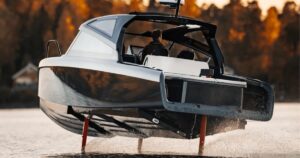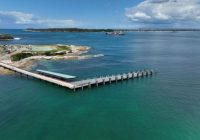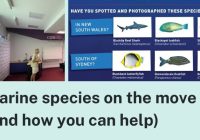Moving ahead from the traditional conception of boating and yachting as a nostalgic experience with wind, water and ancient seamanship, leading companies in the industry have presented their innovative digital products at the Consumer Electronics Show (CES) in Las Vegas recently. The future of boating as presented is digital, connected and high-tech.

Boat brands and large corporations have been investing in new technology to enable un-experienced boaters to drive their boats safely. This has brought the boating and yachting industry to CES, before the domain of domotics, communications and entertainment innovations. The 2023 edition even saw boating companies win prizes.
Foiling
Electric powerboats on hydrofoils were among the most striking products from the yachting industry for the visitors of CES. Once lifted out of the water at foiling speed, hydrofoil boats have dramatically reduced drag in the water. This enables electric powerboats to reach high speeds and long range even with relatively limited battery capacity. Candela from Stockholm presented their C-8, ready for production. The Swedish company partnered with electric automobile brand Polestar, Volvo cars offspring, to develop a long range capacity set-up of batteries, controls and engines. The C-8 can travel 50 nautical miles at its 22 knot cruising speed before re-charging is needed. Key to getting the fast boat to be comfortable and easy to handle above the water on its foils, has been to get the control system working. Computers do the job, company founder Gustav Hasselskog reveals: “An electric hydrofoil boat is inherently unstable, which means it can’t fly unless a computer continually adjusts the hydrofoils. To develop the sensor suite, hardware and software that create a smooth, stable and safe ride took 5 years of R&D. The first flight was magical.”
Simultaneously, Navier Boats from San Francisco presented their N30, an electric powered hydrofoil boat, that claims to have a range of 70 nautical miles at a cruising speed of 20 knots. This 9 meter yacht also uses computer control to adapt the hydrofoil angles for an optimal height given circumstances as wave height and speed. When powering in open water, people at the helm can control the N30 as a normal boat. The computer is furthermore programmed to manoeuvre the boat into a docking slot autonomously. Artificial Intelligence analyses the input from sensors and cameras that report position, current, wind speed and direction, distance to the jetty and objects to avoid. When flying and when docking, the skills come from the boat’s digital systems. As Candela US representative Mikael Mahlberg puts it: “This looks like a boat and you should use it as a boat, but under its carbon fibre skin it is actually a robot.”
Virtual experiences
While these foiling electric powerboat brands are merely outgrowing their start-up phase, industry giants like Brunswick corporation and Volvo Penta join the tech-savvy at CES to display their progression and attract the demanding and very un-traditional age group of Millennials to boating. Volvo Penta takes the show visitors to the Norwegian archipelago of Svalbard, an island group north of the Polar circle. The marine engine manufacturer delivered their 50 foot fully electric cruising yacht to a client who explores the waters around these islands. In virtual reality, people can experience the magic of navigating the breathtaking islands in complete silence. At their booth, Volvo Penta show their vision on future boating: autonomous yachts that detect objects above and under the water surface, that are able to independently navigate their way to a given destination while the people on board are enjoying the water, the surroundings and the experience without the trouble of having to control the boat and learn all kinds of traditional nautical skills.
President Johan Inden of Volvo Marine connects the sustainable gains of electric propulsion with the navigational aid that innovative technology can offer future boaters. At a panel discussion at METSTRADE show last November, he said: “Alongside this shift and core focus on sustainability is the experience of our customers. We believe those two factors are closely connected – an elevated customer experience in new solutions will drive progression on sustainability and vice versa. We are making predictions about how boaters and operators will use their vessels in the future, how their behavior and requirements will change, and therefore, how we can meet these needs in a sustainable way.”
Data mining
World’s largest boating corporation Brunswick had a future boating experience simulator at CES. They had a fully interactive display that allows visitors to pilot a boat virtually through a boating twilight, with controls and a massive 140-degree-wide screen adding to the realism. Visitors could be seated at the helm in the simulator and drive an interactive virtual yacht through waters with limited visibility, experiencing how all kinds of smart technology would assist in getting the boat into an harbour and into their berth without accidents, registering dangers that the person at the helm was unable to see. Brunswick CEO Dave Foulkes says: “This is actually more than an interactive entertainment platform. We can introduce a combination of virtual challenges—docks and other boats in unusual lighting situations—that aren’t easy to replicate in the physical world. We’ll then use that data in the autonomous systems we’re developing.” More than just visitors that could experience the possibilities of future boating as envisioned by Brunswick, CES visitors were helping the company’s research engineers to understand the behaviour of un-experienced boaters to incorporate these findings in the user interfaces of the systems they are developing. The company introduced their Avator 48 volt electric outboard, the Veer line of boats specially developed for use with electric outboards and the Fathom e-power system at CES.
Acceptance
Eliminating harmful emissions from boating has been the driving force for the electrification of boat propulsion. The exhibitors from the yachting industry that presented at CES, seem to have succeeded in this effort. Autonomous sailing is technically made possible by the same brands. Yet, this innovation is still an item for discussion. Without computer control of a speeding hydrofoil boat, the risk of crashing Is just too big. While the computers are already capable of controlling the boat, probably better than people would be, it seems logical to engage Artificial Intelligence for navigating and docking as well. To get insight in public acceptance of boat control by computers, both Brunswick and Volvo Penta created booths that engage the public in trying the new technology, to gather data on their behaviour and preferences in the process. To a yachtsman, all of the new technology seems helpful and allow for a stress free boating experience. However, when the skipper does no longer know how to control the boat himself, accidents may be on their way. Including user interfaces into the technology that stimulate the boaters to learn the beautiful art of navigation, may help to keep cruising the interesting leisure activity it has always been.
From Metstrade.com








